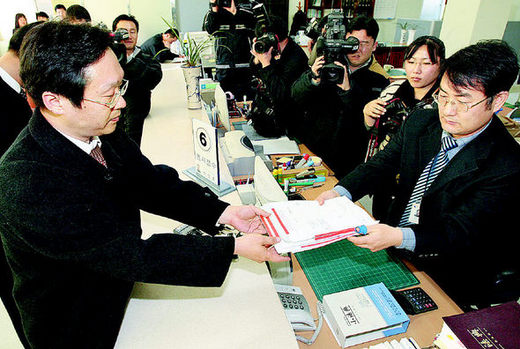 |
|
A legal agent for Hyundai Motor on January 8 submits a file relating to a lawsuit against the trade union, demanding one billion won in restitution for damages. (Yonhap)
|
Abstract figures often used to increase anti-union public sentiment: experts
Hyundai Motor Co., South Korea's top automaker, said on January 9 that it suffered 127.6 billion won (US$135.4 million) in losses due to its labor union's refusal to do overtime work over the past several days. The company's 44,000 union workers engaged in partial strikes over a cut in their year-end bonuses. Previously, Hyundai Motor had announced that losses due to labor strikes since 1987 have amounted to over 10 trillion won. Such astronomical figures tend to influence public opinion against organized labor, as these figures are taken as the real fiscal damage suffered by a company. Indeed, the company's assured pronouncement of such figures fuels this misunderstanding, and the conservative media follow suit, reporting them as if they are exact. But experts point out that the numbers unveiled are not real damages to the company but "disrupted production" caused by strikes, meaning that the company's estimates were determined by simply multiplying vehicles' price by the total number of units that otherwise would have been produced.It is nearly impossible to truly calculate the amount of the real damage done to a company by a strike. But real fiscal damage to Hyundai by the strike, roughly calculated, would be around 3.8 billion won if we multiplied the 8,284 units that would otherwise be produced during the period of time by Hyundai's average operation profit margin of 3.1 percent, not the 127.6 billion won figure Hyundai has come up with. Of course, this figure does not include a variety of other damages suffered by related parts makers that sell their products to Hyundai. But the damages to such companies during the strike did not seem substantive. Even a Hyundai Motor official said that during the partial strikes over the past week, such companies did not register any major losses. Furthermore, the production loss that Hyundai Motor had announced was found to be overestimated in another way: Hyundai Motor workers usually put in extra shifts after labor strikes to compensate for any lost production. For example, economic analysts said that a June strike at the automaker did not disrupt production because unionized workers ramped up production after the labor dispute. For the duration of the entire strike and the period afterward, Hyundai's shares were barely affected. In response to the discrepancy in figures, Professor Gang Sin-jun of Dong-A University said that the main reason for companies to announce such figures as if "disrupted production" equals "real loss" is that they are trying to influence public opinion against labor unions. Hyundai Motor has acknowledged that its estimation of "losses" during this latest strike does not reflect real fiscal loss. One official said that it was inevitable to produce such numbers, as media demand concrete figures right away. He said that the exact loss due to strikes can only be calculated at the end of a fiscal year. In some cases, companies announce totally falsified losses. In July 2005, Asiana Airlines said that it suffered 253 billion won in lost sales due to a one-month pilot strike. But according to analysts, the cancellation of excess, costly routes during the labor dispute actually had a positive impact on the company's operation profit. Indeed, its shares rose during the period. Please direct questions or comments to [englishhani@hani.co.kr]






